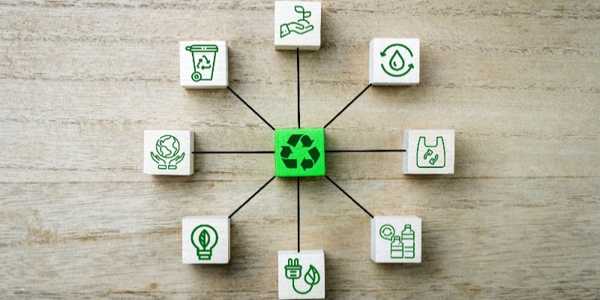- Electronics & Tech News
How Can Companies Integrate Sustainable Practices in Tech Development?
We live in an era where technology plays a significant role in our daily lives. Therefore, it only makes sense to integrate sustainable practices into tech development; it has become a necessity. By incorporating sustainability in tech, tech companies can not only contribute to a healthier planet but also drive innovation and meet the growing demand for eco-friendly products.
This blog explores how companies can integrate Sustainable tech development practices, from designing energy-efficient products to adopting greener manufacturing methods and supporting ethical sourcing.
Designing Energy-Efficient Products
In the quest for sustainability, one of the most impactful areas tech companies can focus on is the energy efficiency of their products. Reducing energy consumption not only lessens environmental impact but also offers consumers more cost-effective solutions. Here are key strategies and examples of companies leading the way in energy-efficient product design:
1. Strategies for Reducing Energy Consumption in Tech Products
Use of Low-Power Components
· Choosing Efficient Hardware: It is crucial to select components such as processors, memory, and displays that are designed to consume less power. This includes using energy-efficient CPUs, GPUs, and other microchips that perform well under low power.
· Power Management Features: Integrating advanced power management features can help minimize energy use when the device is idle or under a light load.
Optimizing Software for Energy Efficiency
· Efficient Coding Practices: Developers can optimize software to reduce energy consumption by writing efficient code, minimizing background processes, and reducing unnecessary computational tasks.
· Adaptive Software Behavior: Implementing software that adapts its performance based on current power availability or usage patterns can also contribute to energy savings. For example, applications that reduce refresh rates or decrease brightness during low power modes can significantly extend battery life.
2. Examples of Companies Successfully Implementing Energy-Efficient Designs
· Apple Inc.
Apple has made significant strides in designing energy-efficient products. The company's M1 chip, used in its latest MacBooks and iPads, is not only powerful but also highly energy-efficient, offering long battery life without compromising performance. Additionally, Apple’s commitment to using recycled materials and renewable energy in its manufacturing process further boosts its sustainability efforts.
· Google
Google has optimized energy consumption in its data centers and consumer products. For example, the company's Pixel phones feature adaptive battery technology that learns user habits to limit background activity and save power. Google's data centers also use custom-designed servers that are tailored for energy efficiency.
· Dell Technologies
Dell has been proactive in reducing the energy consumption of its products. The company offers laptops with energy-efficient designs, including low-power displays and energy-optimized components. Dell's commitment to sustainability is also evident in its recycling programs and use of sustainable materials.
Green Practices in Technology
Adopting green manufacturing practices is a significant step for tech companies aiming to reduce their environmental footprint. These practices involve using sustainable materials, minimizing waste, and adopting renewable energy sources, all of which contribute to a more sustainable production process.

1. Sustainable Materials and Resource Efficiency
Use of Recycled and Recyclable Materials
· Recycled Components: Incorporating recycled materials into products, such as using recycled plastics, metals, and rare earth elements, helps reduce the demand for virgin materials and lowers the overall environmental impact.
· Design for Recyclability: Designing products that are easier to disassemble and recycle at the end of their lifecycle so that valuable materials can be recovered and reused.
Minimizing Waste during Production
· Lean Manufacturing Techniques: Implementing lean manufacturing techniques helps minimize waste by optimizing production processes, reducing excess inventory, and improving material usage efficiency.
· Circular Economy Models: Embracing circular economy models, where products are designed with their entire lifecycle in mind, including end-of-life disposal and recycling, promotes sustainable resource management.
2. Adopting Renewable Energy Sources in Manufacturing Facilities
Renewable Energy Integration: Shifting to renewable energy sources, such as solar, wind, and hydroelectric power, for manufacturing facilities significantly reduces carbon emissions. Many tech companies invest in on-site renewable energy generation or purchase renewable energy credits to offset their carbon footprint.
Case Studies of Companies with Green Manufacturing Initiatives
HP Inc.
HP has made substantial efforts in integrating sustainable practices into its manufacturing processes. The company uses recycled plastics in its products, including its HP ink cartridges made from up to 100% recycled materials.
Tesla
Tesla is a notable example of a company that combines high-tech innovation with sustainable manufacturing. Tesla's Gigafactories are designed to be energy-efficient and are powered, in part, by renewable energy sources such as solar panels. The company's focus on battery recycling and reducing waste in its production processes further exemplifies its commitment to sustainability/
Microsoft
Microsoft has invested in using recycled materials in its products and has taken significant steps to reduce waste and water usage in its data centers and manufacturing facilities. Microsoft is also exploring new technologies to capture and store carbon emissions, furthering its green manufacturing initiatives.
Ethical Sourcing and Supply Chain Management
Ethical sourcing and responsible supply chain management are essential components of sustainability in the tech industry. These practices not only benefit the planet and communities but also enhance brand reputation and build consumer trust.
1. Ensuring Ethical Sourcing of Raw Materials
Avoiding Conflict Minerals
· Definition and Issues: Conflict minerals, such as tantalum, tin, tungsten, and gold, are often mined in conditions of armed conflict and human rights abuses. These minerals are used in many electronic devices, and sourcing them responsibly is crucial to avoid financing violence and exploitation.
· Certification and Reporting: Companies can guarantee ethical sourcing by adhering to international guidelines and certifications, such as the Responsible Minerals Assurance Process (RMAP) and the Conflict-Free Sourcing Initiative (CFSI). Regular audits and reporting on the origin of minerals help maintain accountability and transparency.
Partnering with Responsible Suppliers
· Supplier Code of Conduct: Implementing a strict supplier code of conduct that emphasizes ethical practices, labor rights, and environmental standards is essential. This code should be communicated clearly to all suppliers, and compliance should be monitored through regular audits.
· Long-Term Partnerships: Building long-term relationships with suppliers who share the company's ethical sourcing and sustainability values can foster trust and cooperation, leading to more responsible supply chain practices.
Implementing Transparent Supply Chain Practices
· Traceability and Transparency: Companies should strive for complete traceability in their supply chains, ensuring that every component and raw material's origin can be verified. Transparency in supply chain practices, including public reporting on sourcing policies and practices, helps build consumer confidence.
· Engagement and Collaboration: Engaging with stakeholders, including NGOs, industry groups, and local communities, can help companies stay informed about the latest best practices and challenges in ethical sourcing. Collaborative efforts can lead to industry-wide improvements in supply chain sustainability.
Development of New Materials and Technologies
Eco-Friendly Materials
Developing biodegradable and recyclable materials is a significant innovation in tech manufacturing. These materials help reduce waste and pollution, offering an alternative to conventional plastics and metals that often end up in landfills or oceans.

Advanced Technologies for Efficiency
Innovations in technology can optimize energy use, reduce emissions, and enhance product lifecycle management. For instance, AI can predict and manage energy consumption in data centers, while IoT devices can monitor and optimize resource use in real-time.
Renewable Energy Integration
Developing technologies that integrate renewable energy sources, such as solar panels and wind turbines, into everyday tech products and infrastructure is crucial. It not only reduces reliance on fossil fuels but also promotes the broader adoption of clean energy solutions.
Integrating Sustainability in Tech – A Conclusion
Integrating sustainable practices into tech development is no longer an option but a necessity for companies. Ultimately, the journey towards sustainable tech development is ongoing, requiring continuous effort and collaboration. By committing to sustainable practices, tech companies can make a meaningful impact so that technological advancement goes hand in hand with environmental stewardship and ethical responsibility. This commitment to sustainability is essential not just for the industry's future but for the well-being of our planet and future generations.





